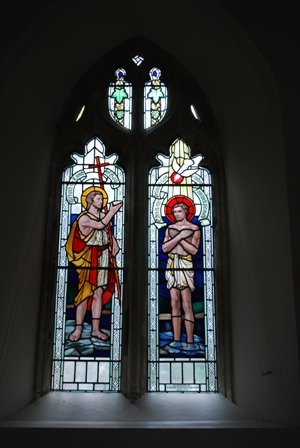Church History - Street Parish Church
The Parish Church of Holy Trinity stands slightly remote from the busy commercial and industrial life of Street, which is why it preserves within the walls of its churchyard its ageless sense of quiet solitude and peace. It is situated within the Vale of Avalon, whose history stretches back in time until it merges with Arthurian and Arimathean legends.
The Chancel is 13th and 14th century with the original tracery and a roof of a type rare in Somerset Churches. The sculptured sedilia are a notable feature; these stone seats for the priests are enriched with decorated arches and pinnacles with 21 tiny heads among the leaves. There is also a decorated pinnacled piscina [washing place] with a canopy. At one time there was a doorway in the north wall of the Chancel the position of which is clearly visible from the exterior. The Chancel arch is also of note.
The Lady Chapel altar is modern and made of panelled oak. Records tell us that in 1890 the choir was 'robed' and occupied the choir stalls where previously had sat the 'village farmers'. In1951 a modern stained glass window, designed and executed by Mrs. R. de Montmorency, was given in memory of several notable parishioners by their children and by friends. The subjects of these windows are The Madonna and Child, The Ascended Christ, the boys Samual and St. John the Baptist, and two local Saints – Gildas and Dunstan.
The window in the north aisle was also designed and executed by Mrs. R. Montmorency and given by Preb. J.A.Li. Armstrong [Rector from 1950 to 1956] and his wife, in memory of their respective fathers. Glastonbury Abbey is the subject of these windows, represented by the figures of St. Joseph of Arimathea and Abbot Whiting – the last Abbot of Glastonbury at its dissolution in 1539 and was cruelly put to death on Glastonbury Tor. The stained glass windows in the south wall were added at the same time. Traces of former stained glass windows can be seen in the other windows on the on the south wall.



The south wall and roof of the nave, the south porch and the tower belong to the early part of the 15th century, a time when Somerset was prospering as England's leading producer of woollen cloth. In 1730 a gallery was built at the west end of the nave, but removed in 1886. In 1826, at a time when church attendance was expanding, the north aisle was added and other restoration work was done. The vestry was added in 1843.
The 1st organ was installed at the west end of the nave in 1831 and was moved when the gallery was removed in 1886. A later organ was gifted in 1904.
Like many fonts in nearby Churches, the font is made of coarse-grained limestone, probably from nearby Doulting Quarry, and although not classified as a good one, it is of the 'decorated' period of architecture and would have been installed when the Chancel was built in the 13th and 14th century,so that it is about 750 years old. Fonts are usually carefully preserved as they used to demonstrate the right to administer baptism and therefore indicated full parochial status. Marks of pre-Reformation cover fastenings are visible on the rim of the font. The inner basin is 12'' deep, so that total immersion was presumably still the general practice when the font was made. The text on the lead lining is probably Victorian. It is interesting to note that the font is cracked horizontally around the bowl below the top moulding, perhaps due to the freezing of the water, which was kept in the bowl for long periods prior to the Reformation.
The belfry houses a peal of 8 bells, the tenor weighing 23 ¾ cwt.[1,209 kilos]. In 1777 the first 4 bells were installed being the present 3rd , 4th , 6th and 7th bells. The 3rd bell bears the inscription 'My treble voice makes hearts rejoice.' The 5th and tenor bells were added in 1805, the 5th being recast in 1891 when the inscription 'God be our guide' was added. The treble bell and 2nd bells were installed in 1903 and the 2nd bell bears the inscription 'Keep Holy the Sabbath day, worship God'. There is sufficient room for the installation of a further 2 bells. The bells were formerly rung from the ground floor and the present ringing chamber was added in 1957, two years after the bells had been rehung. The bells and their fittings were further refurbished in 2007, being sent back to the bell foundry in Loughbourgh for repair and tuning.
The clock was originally installed in 1865; in1953 the face was restored and an electrical mechanism was fitted. Further restoration was carried out during 2011 when the clock face was re-gilded.
The earliest Register of Baptism, Marriages and Burials dates from 1599, one year after Queen Elizabeth the 1st had commanded that every parish should provide itself with a parchment register, and records are fairly complete since that date. The earliest records are written on vellum and contain references to wills made as early as 1543. The Churchwardens' accounts date from 1684 when the wardens were John and Daniel Rood and are prefaced with this sober warning.
Whosoever this office take,
Many heads at him will shake,
And by many suspected to be a knave,
And this is all for our labour and pains we shall have.
There have been 48 Rectors since 1304 and a list of incumbents can be seen on the south wall near the font.
More recently and possibly less famous outside Street, we owe a great debt to the Reverend John Greed, and his indefatigable Churchwarden Mr Garry Sowerby, who oversaw the complete re-ordering of this Church in 2003.
A booklet containing further information can be obtained from Holy Trinity Street or from the Churchwardens.